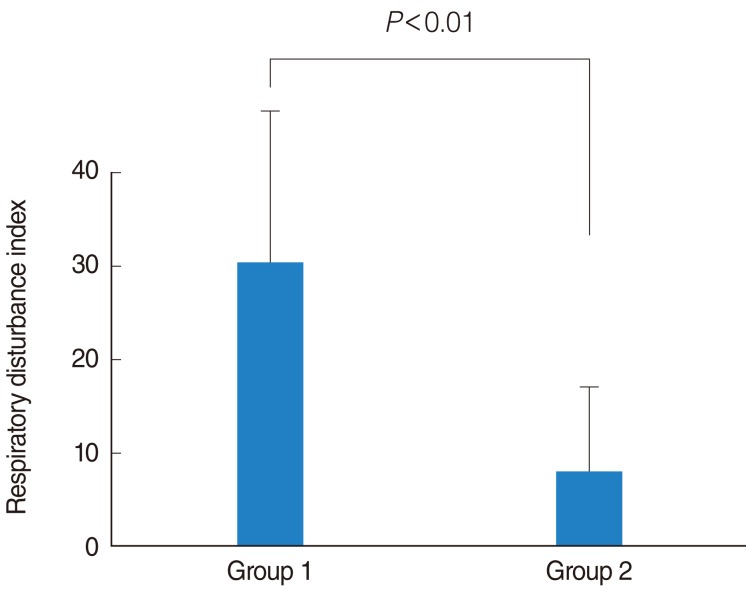Clin Exp Otorhinolaryngol.
2013 Jun;6(2):68-72.
The Effect of Obstructive Sleep Apnea on DNA Damage and Oxidative Stress
- Affiliations
-
- 1Department of Otolaryngology, Head & Neck Surgery, Gil Medical Center, School of Medicine, Gachon University, Incheon, Korea. eyik@naver.com
Abstract
OBJECTIVES
Obstructive sleep apnea syndrome (OSAS) is associated with repeated hypoxia and re-oxygenation. This characteristic of OSAS may cause oxidative stress and DNA damage. However, the link of OSAS with oxidative stress and DNA damage is still controversial. In the current study, we investigated whether OSAS causes DNA damage using alkaline single-cell gel electrophoresis (comet assay) and measuring oxidative stress by monitoring serum malondialdehyde (MDA) levels.
METHODS
From March 2009 to August 2010, 51 patients who underwent polysomnography (PSG) during the night were enrolled in this study. We obtained serum from the patients at 6 AM. DNA damage and oxidative stress were evaluated using a comet assay and measuring serum MDA, respectively. We divided the patients into two groups according to the existence of comets appearing in the comet assay. Group 1 included 44 patients with negative assay results and group 2 consisted of seven patients with positive comet assay findings. We compared the age, gender proportion, PSG data (respiratory disturbance index [RDI], lowest O2 saturation level, and arousal index [AI]), time of disease onset, smoking habits, and serum MDA levels between the two groups.
RESULTS
The average age and gender proportion of the two groups were not statistically different (P>0.05). The average of RDI for group 1 was 30.4+/-18.4 and 8.0+/-7.7 (P<0.01) for group 2. The average of lowest O2 saturation level for group 1 was 81.2+/-7.2 and 87.4+/-6.5 (P<0.05) for group 2. The average AI for group 1 was 32.8+/-15.1 and 20.8+/-7.7 (P<0.05) for group 2. Similarly, serum MDA levels of the two groups were not statistically different (P>0.05). No relationship between positive comet assay results and OSAS severity was identified.
CONCLUSION
Results of the current study showed that OSAS was not associated with DNA damage as measured by comet assays or oxidative stress according to serum MDA levels.
MeSH Terms
Figure
Reference
-
1. Jordan W, Cohrs S, Degner D, Meier A, Rodenbeck A, Mayer G, et al. Evaluation of oxidative stress measurements in obstructive sleep apnea syndrome. J Neural Transm. 2006; 2. 113(2):239–254. PMID: 15959848.
Article2. Ames BN, Shigenaga MK, Hagen TM. Oxidants, antioxidants, and the degenerative diseases of aging. Proc Natl Acad Sci U S A. 1993; 9. 90(17):7915–7922. PMID: 8367443.
Article3. Lavie L. Obstructive sleep apnoea syndrome: an oxidative stress disorder. Sleep Med Rev. 2003; 2. 7(1):35–51. PMID: 12586529.4. Sofic E, Rustembegovic A, Kroyer G, Cao G. Serum antioxidant capacity in neurological, psychiatric, renal diseases and cardiomyopathy. J Neural Transm. 2002; 5. 109(5-6):711–719. PMID: 12111462.
Article5. Carpagnano GE, Kharitonov SA, Resta O, Foschino-Barbaro MP, Gramiccioni E, Barnes PJ. 8-Isoprostane, a marker of oxidative stress, is increased in exhaled breath condensate of patients with obstructive sleep apnea after night and is reduced by continuous positive airway pressure therapy. Chest. 2003; 10. 124(4):1386–1392. PMID: 14555570.
Article6. Dyugovskaya L, Lavie P, Lavie L. Increased adhesion molecules expression and production of reactive oxygen species in leukocytes of sleep apnea patients. Am J Respir Crit Care Med. 2002; 4. 165(7):934–939. PMID: 11934717.
Article7. Schulz R, Mahmoudi S, Hattar K, Sibelius U, Olschewski H, Mayer K, et al. Enhanced release of superoxide from polymorphonuclear neutrophils in obstructive sleep apnea: impact of continuous positive airway pressure therapy. Am J Respir Crit Care Med. 2000; 8. 162(2 Pt 1):566–570. PMID: 10934088.8. Christou K, Markoulis N, Moulas AN, Pastaka C, Gourgoulianis KI. Reactive oxygen metabolites (ROMs) as an index of oxidative stress in obstructive sleep apnea patients. Sleep Breath. 2003; 9. 7(3):105–110. PMID: 14569521.
Article9. Kontogianni K, Messini-Nikolaki N, Christou K, Gourgoulianis K, Tsilimigaki S, Piperakis SM. DNA damage and repair capacity in lymphocytes from obstructive sleep apnea patients. Environ Mol Mutagen. 2007; 12. 48(9):722–727. PMID: 17973309.
Article10. Jordan W, Reinbacher A, Cohrs S, Grunewald RW, Mayer G, Ruther E, et al. Obstructive sleep apnea: Plasma endothelin-1 precursor but not endothelin-1 levels are elevated and decline with nasal continuous positive airway pressure. Peptides. 2005; 9. 26(9):1654–1660. PMID: 16112406.
Article11. Barcelo A, Miralles C, Barbe F, Vila M, Pons S, Agusti AG. Abnormal lipid peroxidation in patients with sleep apnoea. Eur Respir J. 2000; 10. 16(4):644–647. PMID: 11106206.
Article12. Lavie L, Vishnevsky A, Lavie P. Evidence for lipid peroxidation in obstructive sleep apnea. Sleep. 2004; 2. 27(1):123–128. PMID: 14998248.13. Ozturk L, Mansour B, Yuksel M, Yalcin AS, Celikoglu F, Gokhan N. Lipid peroxidation and osmotic fragility of red blood cells in sleep-apnea patients. Clin Chim Acta. 2003; 6. 332(1-2):83–88. PMID: 12763284.14. Muns G, Rubinstein I, Bergmann KC. Phagocytosis and oxidative burst of blood phagocytes in chronic obstructive airway disease. Scand J Infect Dis. 1995; 27(4):369–373. PMID: 8658072.15. Svatikova A, Wolk R, Lerman LO, Juncos LA, Greene EL, McConnell JP, et al. Oxidative stress in obstructive sleep apnoea. Eur Heart J. 2005; 11. 26(22):2435–2439. PMID: 16105851.
Article16. Singh NP, McCoy MT, Tice RR, Schneider EL. A simple technique for quantitation of low levels of DNA damage in individual cells. Exp Cell Res. 1988; 3. 175(1):184–191. PMID: 3345800.
Article17. Pilz J, Meineke I, Gleiter CH. Measurement of free and bound malondialdehyde in plasma by high-performance liquid chromatography as the 2,4-dinitrophenylhydrazine derivative. J Chromatogr B Biomed Sci Appl. 2000; 6. 742(2):315–325. PMID: 10901136.
Article18. Wali SO, Bahammam AS, Massaeli H, Pierce GN, Iliskovic N, Singal PK, et al. Susceptibility of LDL to oxidative stress in obstructive sleep apnea. Sleep. 1998; 5. 21(3):290–296. PMID: 9595608.
- Full Text Links
- Actions
-
Cited
- CITED
-
- Close
- Share
- Similar articles
-
- Obstructive Sleep Apnea in Interstitial Lung Disease
- Neurocognitive Dysfunction Related with Sleep Factors in Patients with Obstructive Sleep Apnea
- A Case of Huge Lingual Tonsillar Hypertrophy Causing Obstructive Sleep Apnea in Adult
- Pathogenesis of Obstructive Sleep Apnea
- Effects of Menopause on Obstructive Sleep Apnea



